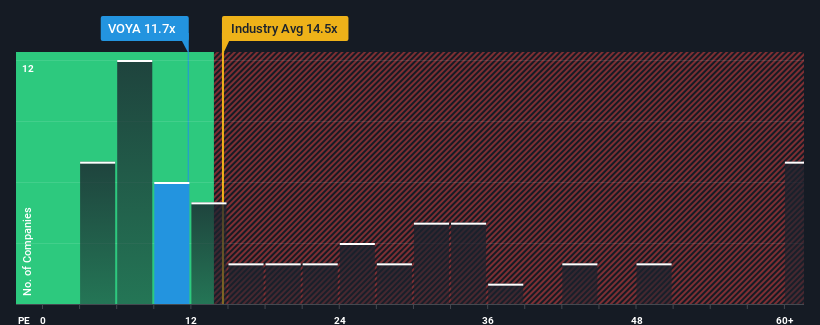- United States
- /
- Diversified Financial
- /
- NYSE:VOYA
A Piece Of The Puzzle Missing From Voya Financial, Inc.'s (NYSE:VOYA) Share Price

When close to half the companies in the United States have price-to-earnings ratios (or "P/E's") above 17x, you may consider Voya Financial, Inc. (NYSE:VOYA) as an attractive investment with its 11.7x P/E ratio. Nonetheless, we'd need to dig a little deeper to determine if there is a rational basis for the reduced P/E.
There hasn't been much to differentiate Voya Financial's and the market's retreating earnings lately. One possibility is that the P/E is low because investors think the company's earnings may begin to slide even faster. If you still like the company, you'd want its earnings trajectory to turn around before making any decisions. In saying that, existing shareholders may feel hopeful about the share price if the company's earnings continue tracking the market.
Check out our latest analysis for Voya Financial

How Is Voya Financial's Growth Trending?
The only time you'd be truly comfortable seeing a P/E as low as Voya Financial's is when the company's growth is on track to lag the market.
Taking a look back first, we see that there was hardly any earnings per share growth to speak of for the company over the past year. Still, the latest three year period has seen an excellent 314% overall rise in EPS, in spite of its uninspiring short-term performance. So we can start by confirming that the company has done a great job of growing earnings over that time.
Turning to the outlook, the next three years should generate growth of 19% each year as estimated by the twelve analysts watching the company. Meanwhile, the rest of the market is forecast to only expand by 12% per year, which is noticeably less attractive.
With this information, we find it odd that Voya Financial is trading at a P/E lower than the market. It looks like most investors are not convinced at all that the company can achieve future growth expectations.
The Bottom Line On Voya Financial's P/E
Using the price-to-earnings ratio alone to determine if you should sell your stock isn't sensible, however it can be a practical guide to the company's future prospects.
We've established that Voya Financial currently trades on a much lower than expected P/E since its forecast growth is higher than the wider market. When we see a strong earnings outlook with faster-than-market growth, we assume potential risks are what might be placing significant pressure on the P/E ratio. It appears many are indeed anticipating earnings instability, because these conditions should normally provide a boost to the share price.
Don't forget that there may be other risks. For instance, we've identified 2 warning signs for Voya Financial that you should be aware of.
If P/E ratios interest you, you may wish to see this free collection of other companies with strong earnings growth and low P/E ratios.
New: Manage All Your Stock Portfolios in One Place
We've created the ultimate portfolio companion for stock investors, and it's free.
• Connect an unlimited number of Portfolios and see your total in one currency
• Be alerted to new Warning Signs or Risks via email or mobile
• Track the Fair Value of your stocks
Have feedback on this article? Concerned about the content? Get in touch with us directly. Alternatively, email editorial-team (at) simplywallst.com.
This article by Simply Wall St is general in nature. We provide commentary based on historical data and analyst forecasts only using an unbiased methodology and our articles are not intended to be financial advice. It does not constitute a recommendation to buy or sell any stock, and does not take account of your objectives, or your financial situation. We aim to bring you long-term focused analysis driven by fundamental data. Note that our analysis may not factor in the latest price-sensitive company announcements or qualitative material. Simply Wall St has no position in any stocks mentioned.
About NYSE:VOYA
Voya Financial
Engages in the provision of workplace benefits and savings products in the United States and internationally.
Undervalued established dividend payer.


